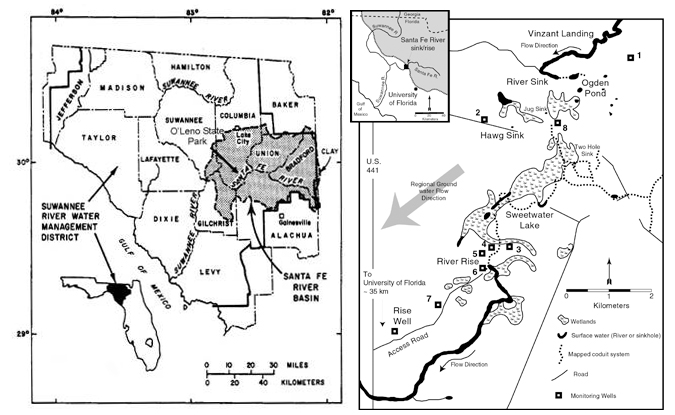Mineral-dissolved organic matter interaction in a carbonate aquifer: Oleno, FL
Mineral-organic matter (OM) interactions have been shown to influence OM preservation in soils and sediments and nanometer-sized pores have been shown to be capable of adsorbing organic compounds. However, the importance of mineral nanopores in OM preservation and transformation in a natural setting has not been demonstrated. Further, very few studies have directly examined OM-mineral interactions of any type in the subsurface.
Using a combination of field and experimental approaches, this study investigates the influence of calcite mineral surfaces, including the effect of mineral nanopores, on the transformation of natural dissolved organic matter (NDOM). Changes in NDOM composition and molecular size as it traverses a 5 km subsurface section of the Santa Fe River in north-central Florida (through karst intergranular matrices between River Sink and River Rise) will be compared to laboratory adsorption/desorption experiments (both batch and column) using the same sorbents and sorptives. The possible influence of subsurface microbial transformation and variations in pore size and structure will also be explored.
My laboratory is engaged in a number of projects investigating these interactions, all of which have important implications for water resource management, human health and environmental quality. In addition to examining natural, surface-water/deep-water exchange systems, we are cooperating with the Florida Geological Survey on a project to examine the influence of organic matter and microbes on arsenic release during aquifer storage and recovery (ASR), a relatively new underground water storage strategy.
Environmental Consequences of Nutrients and Organic Matter Injection into Carbonate Aquifers; Implications for Water Quality in Aquifer Storage and Recovery (ASR) Technology
Though of extreme relevance to the environmental health implications of ASR, the fate of nutrients in the environment and global carbon cycling, very few studies have specifically examined NDOM, nutrients, microbes, and mineral dynamics in a relatively pristine carbonate aquifer. The proposed study takes a laboratory approach to understanding these interactions, saving field approaches for a future study. There are many important interactions between NDOM, minerals, and microbes that require examination. And nutrients, such as N and P, are an integral part of biogeochemical cycling in the subsurface because they are released when NDOM is decomposed by some microbes and utilized by other microbes in creating their own organic biomass. Further, just as minerals may abiotically adsorb NDOM, P is likely readily adsorbed by many minerals and released in the dissolution of others (e.g. apatite).
The focus of this study is to examine;
- the influence of calcite and apatite on the supply, adsorption, transformation and possibly long-term sequestration of NDOM and nutrients in a carbonate aquifer,
- the rates of microbial utilization and transformation of NDOM and the associated release of nutrients in the presence of carbonate minerals, and,
- the relative influence of NDOM, nutrients and microbes on carbonate mineral dissolution or precipitation and the associated release of metals in a carbonate aquifer.

